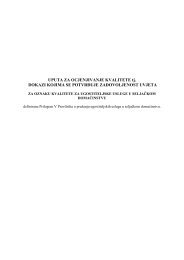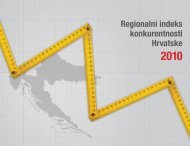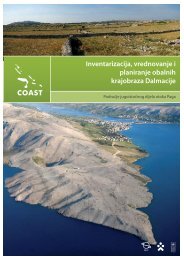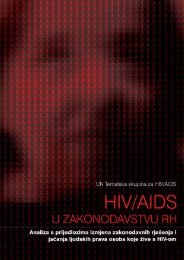KEY CHALLENGESCHAPTER 4- People with disabilities: Physical barriers to institutionsand social stigma, combined with a lack ofemployment opportunities, and a problematic relationshipwith an ineffective health system, work toexclude people with disabilities. Focus group interviews(<strong>UNDP</strong>, 2006b) show a fundamental disconnectbetween costly, medical assessment procedures andthe inadequate benefits which these allow access to.This indicates a need to shift policies and practice infour directions. First, towards a more realistic packageof cash and care benefits based on a thoroughsocial and medical assessment. Second, to providereal incentives on both the supply and demand side,to promote participation in the labour market, whichis seen as a good investment in terms of productivityin the longer-run (cf. ILO, 2006). Third, given the lackof skills and trust as evidenced in the focus groups,there needs to be a shift in responsibility for advice,guidance, and legal counsel away from CSW andtowards new agencies, perhaps run by coalitions ofdisability associations. Fourth, and perhaps most difficultto achieve politically, there is a need to movetowards a system where benefits relate more to thenature of the disability than to the cause (whetherwar-related, work-related, or other). Whilst pointingout that veteran benefits are not designed in termsof poverty alleviation but, rather, represent “a publicpolicy choice to recognise past military service”, theWorld Bank estimates that public exp<strong>end</strong>itures onsuch benefits amounted to 1.63% of GDP in 2004,representing approximately 41% of social benefits(World Bank, 2005; 1).- The Long-Term Unemployed: Despite some encouragingtr<strong>end</strong>s in the reduction of unemploymentrates in <strong>Croatia</strong>, Chapter 3.7 illustrates that thelong-term unemployed still comprise more thanhalf of the total unemployed, with the number ofvery long-term unemployed increasing. Over 3% ofthe <strong>Croatia</strong>n population is long-term unemployed,representing a significant portion of households atrisk of poverty and social exclusion. This group suffersfrom low income, poor access to health andother services, and has little trust in institutions. Thechallenge for policy-makers is to provide adequateincome maintenance as well as support job-searchefforts and skills enhancement. Regionally basedstrategies may be needed given the varying causesof long-term unemployment. Clear targets mayneed to be set to ensure that the portion of the longtermunemployed who receive training and supportraises the low figure of 2.5% envisaged under theNational Employment Action Plan.- Varied Family Forms - Single-parents and largefamilies: The <strong>Croatia</strong>n family structure is still verytraditional, although the number of single-parentsis now around the EU average. As Chapter 3.6 illustrates,single-parent families face numerous difficulties;they are at a higher risk of poverty, and abouthalf of them struggle financially. While having tocope with underdeveloped services, it is understandablethat single-parent families dep<strong>end</strong> onhelp received from the ext<strong>end</strong>ed family. Those whocannot rely on that help experience the highest levelsof social exclusion. Single-parent families alsoface considerable problems in balancing work andfamily obligations, placing them in a disadvantagedposition when trying to obtain paid work. Largefamilies are in a similar position, with an even higherrisk of poverty than single-parent families. The threatof poverty for larger families results from a combinationof factors, including lower levels of educationand poor employment records. Both types of familiesrequire special social attention and a variety ofmeasures to address their specific needs.- Families with Young Children: A recent WorldBank study found that, while poverty in <strong>Croatia</strong> isgenerally stable throughout the life cycle, the oneexception can be found among children aged 0-4years. These small children have the second highestvalue in the poverty gap index, necessitating specialconsideration for households with infants (WorldBank, 2006; 18). The importance of an integrated setof policies for early childhood education and childcare is recognised increasingly in both developedand developing countries (cf. Haddad, 2002), basedon the principles of universality and inclusiveness, aswell as horizontal and vertical co-ordination. Suchpolicies are clearly necessary in <strong>Croatia</strong>.- Minority Ethnic groups - Roma and Serbianreturnees: As in most of South Eastern and CentralEurope, the Roma face structural exclusion in <strong>Croatia</strong>.This is also the situation with members of the Serbianminority population, particularly returnees. In bothcases, the strengthening of anti-discriminatorylegislation is needed, coupled with an area-based139
CHAPTER 4KEY CHALLENGESapproach to development (<strong>UNDP</strong>, 2006b). In thecase of the Roma, putting an <strong>end</strong> to discriminationin the labour market is an essential first step towardschallenging the Roma’s ‘asymmetrical’ relationshipwith social welfare. Above all, a focus on investmentsin education and housing is crucial. For Serbianreturnees, there is a need to emphasise a humanrights approach and to consider legal pre-conditionsfor inclusion as a priority.- Institutionalised populations: In part becauseof the less dramatic situation found in <strong>Croatia</strong>compared to, for example, Bulgaria and Romania,there is a danger of failing to respond to the structuralexclusion of various institutionalised populationsin <strong>Croatia</strong> (such as, children without parental care,children with disabilities, adults with disabilities, andjuvenile and adult off<strong>end</strong>ers). Institutionalisation,in some cases, appears to produce exclusion as itinvolves segregation from family and other support,often in remote settings. Moreover, those who leaveinstitutions are not prepared for re-integration orinclusion in society. A wholesale commitment tonew forms of community care is needed. Again, thisneeds to be tied to area-based assessments of needand the provision of more ‘intermediate’ resourcesto avoid over-reliance, either on costly institutionalcare or on unsupported and over stretched familycare (Bošnjak and Stubbs, 2006).- Older people without a pension: The latest WorldBank poverty study (World Bank, 2006) indicatesthat the risk of poverty increases with age. Elderlyheaded households face a poverty risk twice thatof the general population. A higher risk is facedby households headed by females aged 65+ andby female single-resident households. Withinhouseholds headed by elderly people, those whodo not receive pensions are particularly vulnerable,facing a poverty risk more than five times the nationalaverage. The World Bank study shows that no lessthat 62% of those aged 65+ who do not receive apension are in poverty, compared to 19% of thosein the same age group who do receive a pension.Chapter 3.1 suggests that one-fifth the populationover 65 (131 414 people) do not receive a pension.The case for introducing some kind of ‘social pension’appears to be very strong in <strong>Croatia</strong>. It is obvious thatolder people are not a homogenous group – while aminority is in a relatively good position, the majorityis made up of a number of different, highly excluded,sub-groups. The focus groups survey also showsthat assistance to older people with low incomescould, to a considerable extent, be realized throughmeasures which would lower costs for medical andrelated services.4.3 Geography of Exclusion andRegional InequalitiesUntil recently, there was very little accurate informationon the extent of regional inequality in <strong>Croatia</strong>.However, a number of recent studies have begun toproduce a rather consistent, and somewhat worrying,picture of spatially concentrated disadvantage,although much of this is still pitched at the level oflarger regions and counties, with municipal leveland neighbourhood data almost completely lacking.County level data shows the need for a set ofdevelopment indicators rather than only using GDPper capita. Supplementing the World Bank tableswith <strong>UNDP</strong> Quality of Life survey data (<strong>UNDP</strong>, 2006a)indicates that there are links between per capita GDPand levels of social exclusion (see Table 9). While theWorld Bank report emphasises that the bottom fivecounties in terms of per capita GDP is not correlatedespecially with income or consumption poverty, itdisplays a stronger correlation with social exclusion.According to the <strong>UNDP</strong> survey, three of the countieswith the highest levels of social exclusion are alsoamong those with the lowest per capita GDP. Anotherway of reading Table 9 is to consider that 12 of 21counties appear in the bottom five in at least one ofthe six indicators, with two counties, Osijek-Baranja140

















